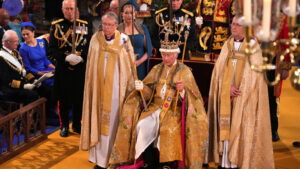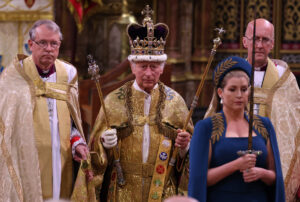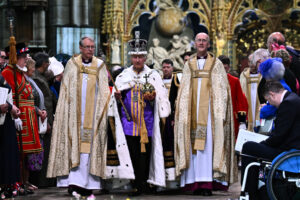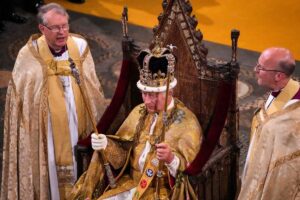
Charles III on Saturday finally met his date with destiny after a lifetime as heir to his late mother Queen Elizabeth II, as he was officially crowned king in the first coronation in Britain since 1953.
At exactly 12:02 pm, the Archbishop of Canterbury Justin Welby placed the solid gold St Edward’s Crown on Charles’s head as a sacred and ancient symbol of the monarch’s authority.
Cries of “God Save the King” rang out from the 2,300-member congregation at Westminster Abbey and trumpet fanfares sounded at the climax of the solemn religious confirmation of his accession.
Outside, ceremonial gun salutes blasted out across land and sea while bells pealed in celebration at churches.

Charles, 74, will wear the St Edward’s Crown only once during his reign. His wife, Camilla, 75, was crowned queen in a simpler ceremony soon afterwards.
The build-up to the Christian ceremony of prayer and praise — steeped in 1,000 years of British history and tradition, with sumptuous robes and priceless regalia — has been mostly celebratory.
But even before Charles and Camilla left Buckingham Palace for a rainy procession to the abbey, police arrested dozens of protesters using new powers rushed onto the statute book to crack down on direct action groups.
The anti-monarchy movement Republic — which wants an elected head of state — said six of its organisers were detained, while climate activists Just Stop Oil said 19 of its number were held.
Nevertheless, dozens of Republic activists held aloft banners on the route of the procession route, declaring: “Not My King.”

Both Human Rights Watch and Amnesty International voiced concern at the arrests. “This is something you would expect to see in Moscow, not London,” HRW said.
London’s Metropolitan Police has some 11,500 officers on the streets in one of its biggest ever security operations. It has warned that it has an “extremely low threshold” for protests.
As well as being the first coronation in 70 years, it was the first of a king since 1937. It was only the second to be televised and the first in colour and streamed online.

Much of the two-hour Anglican service, in which Charles pledged “I come not to be served but to serve”, would have been recognisable to the 39 other monarchs crowned at Westminster Abbey since 1066.
But while many of the intricate rituals and ceremony to recognise Charles as his people’s “undoubted king” remained, the king sought to bring other aspects of the service up to date.
Female bishops and choristers participated for the first time, as did leaders of Britain’s non-Christian faiths, while its Celtic languages — Welsh, Scottish Gaelic and Irish Gaelic — featured prominently.
A gospel choir sang for the first time at a coronation while a Greek choir intoned a psalm in tribute to Charles’s late father, Prince Philip, who was born on the island of Corfu.
As king, Charles is supreme governor of the Church of England and has described himself as a “committed Anglican Christian”.
But he heads a more religiously and ethnically diverse country than the one his mother inherited in the shadow of World War II.
As such, he sought to make the congregation more reflective of British society, inviting ordinary members of the public to sit alongside heads of state and global royalty.
In another change, the coronation themes mirrored his lifelong interest in biodiversity and sustainability.
Seasonal flowers and foliage were brought from the wind-battered Isle of Skye in northwest Scotland to Cornwall at the tip of England’s southwest coast to fill the abbey.
Ceremonial vestments from previous coronations were reused, and the anointing oil — created from olives on groves on the Mount of Olives and perfumed with essential oils — was vegan.
Charles was anointed out of sight of the congregation behind a three-sided screen in front of the High Altar, to the strains of Handel’s soaring anthem “Zadok the Priest”, sung at every coronation since 1727.
Opposition
Rishi Sunak — Britain’s first prime minister of colour, who gave a reading from the Bible at the service — has described the coronation as “a proud expression of our history, culture and traditions”.
But not everyone is convinced: polling indicates waning support for the monarchy, particularly among younger people.
Charles’s eldest brother Prince Andrew — sidelined due to his friendship with the late convicted paedophile Jeffrey Epstein — was booed as he headed to the abbey.
Another royal exile, Prince Harry, who has criticised the family since leaving for the United States in 2020, attended the coronation on his own.
Overseas, Charles’s position as the hereditary monarch and head of state of 14 Commonwealth countries looks increasingly fragile.
Jamaica and Belize both signalled this week that they are moving toward becoming republics, while Australia, Canada and others may eventually follow suit.
Britons struggling with the soaring cost of living have meanwhile questioned why taxpayers should stump up for the coronation, with the bill estimated to be over £100 million ($126 million).
Support
Yet the huge crowds of royal fans that have been building all week on The Mall outside Buckingham Palace indicate that the royals still have a central role in British culture and history.
Many of those camping out to watch have flown in from abroad, underlining the royal family’s untouched position as Britain’s leading global brand.
Christine Wilen travelled from Niagara Falls in Canada for the event.
“I’m very excited to be here, to be part of this history,” said Wilen, wearing a visor and sweatshirt in Canadian colours.
“It’s just too good an opportunity to miss,” said Nick Demont, 60, outside the abbey. “There’s a good chance I won’t see another one.”
Comments